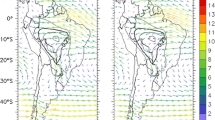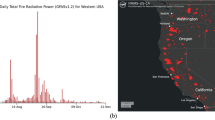Abstract
The atmospheric transport of biomass burning emissions in the South American and African continents is being monitored annually using a numerical simulation of air mass motions; we use a tracer transport capability developed within RAMS (Regional Atmospheric Modeling System) coupled to an emission model. Mass conservation equations are solved for carbon monoxide (CO) and particulate material (PM2.5). Source emissions of trace gases and particles associated with biomass burning activities in tropical forest, savanna and pasture have been parameterized and introduced into the model. The sources are distributed spatially and temporally and assimilated daily using the biomass burning locations detected by remote sensing. Advection effects (at grid scale) and turbulent transport (at sub-grid scale) are provided by the RAMS parameterizations. A sub-grid transport parameterization associated with moist deep and shallow convection, not explicitly resolved by the model due to its low spatial resolution, has also been introduced. Sinks associated with the process of wet and dry removal of aerosol particles and chemical transformation of gases are parameterized and introduced in the mass conservation equation. An operational system has been implemented which produces daily 48-h numerical simulations (including 24-h forecasts) of CO and PM2.5, in addition to traditional meteorological fields. The good prediction skills of the model are demonstrated by comparisons with time series of PM2.5 measured at the surface.
Similar content being viewed by others
References
Andreae, M.: 1991, Biomass burning: its history, use and distribution and its impact on environmental quality and global climate. In: J.S. Levine (ed.), Global Biomass Burning: Atmospheric, Climatic and Biospheric Implications, pp. 3–21, MIT Press, Cambridge, Mass.
Kaufman, Y.: 1995, Remote sensing of direct and indirect aerosol forcing. In: R.J. Charlson and J. Heintzenberg (eds.), Aerosol Forcing of Climate, pp. 297–332, John Wiley & Sons Ltd., Chichester.
Scholes, R., Ward, D. and Justice, C.: 1996, Emissions of trace gases and aerosols particles due to vegetation burning in southern hemisphere Africa, J. Geophys. Res. 101(D19), 23667–23676.
Duncan, B., Martin, R., Staudt, A., Yevich, R. and Logan, J.: 2003, Interannual and seasonal variability of biomass burning emissions constrained by satellite observations, J. Geophys. Res. 108(D2), 4100.
Prins, E., Feltz, J., Menzel, W. and Ward, D.: 1998, An overview of GOES-8 diurnal fire and smoke results for SCAR-B and 1995 fire season in South America, J. Geophys. Res. 103(D24), 31821–31835.
Artaxo P., Gerab, F., Yamasoe, M. and Martins, J.: 1994, Fine mode aerosol composition in three long-term atmospheric monitoring sampling stations in the Amazon basin, J. Geophys. Res. 99, 22857–22867.
Artaxo P., Fernandes, E., Martins, J., Yamasoe, M., Hobbs, P., Maenhaut, W., Longo K. and Castanho, A.: 1998, Large-scale aerosol source apportionment in Amazonia, J. Geophys. Res. 103, 31837–31847.
Echalar, F., Artaxo, P., Martins, J., Yamasoe M. and Gerab, F.: 1998, Long-term monitoring of atmospheric aerosols in the Amazon basin: Source identification and apportionment, J. Geophys. Res. 103, 31849–31864.
Reid, J., Hobbs, P., Ferek, R., Blake, D., Martins, J., Dunlap, M. and Liousse, C.: 1998, Physical, chemical and optical properties of regional hazes dominated by smoke in Brazil, J. Geophys. Res. 103, 32059–32080.
Jacobson, M.: 2001, Global direct radiative forcing due to multicomponent anthropogenic and natural aerosols, J. Geophys. Res. 106(D2), 1551–1568.
Sato, M., Hansen, J., Koch, D., Lacis, A., Ruedy, R., Dubovik, O., Holben, B., Chin, M. and Novakov, T..: 2003, Global atmospheric black carbon inferred from AERONET, Proc. Natl. Acad. Sci. USA, 100, 6319–6324.
Andreae, M.: 2001, The dark side of aerosols, Nature, 409, 671–672.
Cotton, W. and Pielke, R.: 1996, Human Impacts on Weather and Climate, Cambridge University Press, New York.
Rosenfeld, D.: 1999, TRMM observed first direct evidence of smoke from forest fires inhibiting rainfall, Geophys. Res. Lett. 26, 3101.
Grell, G., Emeis, S., Stockwell, W., Schoenemeyer, T., Forkel, R., Michalakes, J., Knoche, R. and Seidl, W.: 2000, Application of a multiscale, coupled MM5/chemistry model to the complex terrain of the VOTALP valley campaign, Atmos. Env. 34, 1435–1453.
Chatfield, R., Vastano, J., Singh, H. and Sachse, G.: 1996, A general model of how fire emissions and chemistry produce African/oceanic plumes (O3, CO, PAN, smoke), J. Geophys. Res. 101(D19), 24279–24306.
Chatfield, R., Guo, Z., Sachse, G., Blake, D. and Blake, N.: 2002, The subtropical global plume in the Pacific Exploratory Mission-Tropics A (PEM-Tropics A), PEM-Tropics B and the Global Atmospheric Sampling Program (GASP): How tropical emissions affect the remote Pacific. J. Geophys. Res., 107(D16), 4278.
Chin, M., Rood, R., Lin, S.-J., Muller, J.-F. and Thompson, A.: 2000, Atmospheric sulfur cycle simulated in the global model GOCART: Model description and global properties, J. Geophys. Res. 105(D20), 24671–24687.
Brasseur, G., Hauglustaine, D., Walters, S., Rasch, P., Müller, J.-F., Granier, C. and Tie, X.: 1998, MOZART, a global chemical transport model for ozone and related chemical tracers, 1: Model description, J. Geophys. Res. 103(D21), 28265–28289.
Horowitz, L., Walters, S., Mauzerall, D., Emmons, L., Rasch, P., Granier, C., Tie, X., Lamarque, J.-F., Schultz, M. and Brasseur, G.: 2003, A global simulation of tropospheric ozone and related tracers: Description and evaluation of MOZART, version 2, J. Geophys. Res. 108(D24), 4784.
Walko, R., Band, L., Baron J., Kittel, F., Lammers, R., Lee, T., Ojima, D., Pielke, R., Taylor, C., Tague, C., Tremback, C. and Vidale, P.: 2000, Coupled atmosphere-biophysics-hydrology models for environmental modeling, J. Appl. Meteorol. 39, 931–944.
Lobert, J.M. and Warnatz, J.: 1993, Emissions from the combustion process in vegetation. In: P.J. Crutzen and J. Goldamner (eds.), Fire in the Environment: Its Ecological, Atmospheric and Climatic Importance, pp. 15–38, John Wiley & Sons Ltd., Chichester.
Ward, E., Susott, R., Kaufman, J., Babbit, R., Cummings, D., Dias, B., Holben, B., Kaufman, Y., Rasmussen, R. and Setzer, A.: 1992, Smoke and fire characteristics for cerrado and deforestation burns in Brazil: BASE-B Experiment, J. Geophys. Res. 97(D13), 14601–14619.
Ferek, J., Reid, J. and Hobbs, P.: 1996, Emission factors of hydrocarbons, halocarbons, trace gases and particles from biomass burning in Brazil. In: V. Kirchhoff (ed.), Smoke/Sulfate, Clouds and Radiation — Brazil (SCAR-B) Proceedings, pp. 35–39, Transtec Editorial, Fortaleza.
Andreae, M. and Merlet, P.: 2001, Emission of trace gases and aerosols from biomass burning, Global Biogeochem. Cycles, 15, 955–966.
Pereira, M.: 1988, Detecção, Monitoramento e Análises de alguns Impactos Ambientais de Queimadas na Amazônia Usando Dados de Avião e dos Satélites NOAA e LANDSAT. Dissertaç ão de mestrado, INPE-4503-TDL/326, 268 p., Instituto Nacional de Pesquisas Espaciais (in Portuguese).
Setzer, A. and Pereira, M.: 1991, Amazonia biomass burnings in 1987 and an estimate of their tropospheric emissions, Ambio, 20, 19–22.
Prins, E. and Menzel, W.: 1992, Geostationary satellite detection of biomass burning in South America, Int. J. Remote Sens., 13, 2783–2799.
Matson, M. and Dozier, J.: 1981, Identification of sub-resolution high temperature sources using a thermal IR sensor, Photogram. Eng. Remote Sens., 47, 1311–1318.
Prins, E., Menzel, W. and Ward, D.: 1996, GOES-8 ABBA diurnal fire monitoring during SCAR-B. In: V. Kirchhoff (ed.), Smoke/Sulfate, Clouds and Radiation — Brazil (SCAR-B) Proceedings, pp. 153–157, Transtec Editorial, Fortaleza.
Chatfield, R. and Crutzen, P.: 1984, Sulfur dioxide in remote oceanic air: Cloud transport of reactive precursors, J. Geophys. Res., 89(D5), 7111–7132.
Pickering, K., Dickerson, R., Huffman, G., Boatman. J. and Schanot, A.: 1988, Trace gas transport in the vicinity of frontal convective clouds, J. Geophys. Res. 93(D1), 759–773.
Chatfield, R. and Delany, A.: 1990, Convection links biomass burning to increased tropical ozone: However, models will tend to overpredict O3, J. Geophys. Res. 95(D12), 18473–18488.
Thompson, A., Pickering, K., Dickerson, R., Ellis, Jr. W., Jacob, D., Scala, J., Tao, W.-K., McNamara, D. and Simpson, J.: 1994, Convective transport over the Central United States and its role in regional CO and ozone budgets, J. Geophys. Res. 99(D09), 18703–18711.
Freitas, S., Silva Dias, M., Silva Dias, P., Longo, K., Artaxo, P., Andreae, M. and Fischer, H.: 2000, A convective kinematic trajectory technique for low-resolution atmospheric models, J. Geophys. Res. 105(D19), 24375–24386.
Longo, K., Thompson, A., Kirchhoff, V., Remer, L., Freitas S., Silva Dias, M., Artaxo, P., Hart, W., Spinhirne, J. and Yamasoe, M.: 1999, Correlation between smoke and tropospheric ozone concentration in Cuiabá during Smoke, Clouds and Radiation-Brazil (SCAR-B), J. Geophys. Res. 104(D10), 12113.
Freitas, S., Silva Dias, M. and Silva Dias, P.: 2000, Modeling the convective transport of trace gases by deep and moist convection, Hybrid Meth. Eng., 2(3), 317–330.
Galanter, M., Levy, II H. and Carmichael, G.: 2000, Impacts of biomass burning on tropospheric CO, NOx, and O3, J. Geophys. Res. 105(D5), 6633–6653.
Andreae, M., Artaxo, P., Fischer, H., Freitas, S., Grégoire, J.-M., Hansel, A., Hoor, P., Kormann, R., Krejci, R., Lange, L., Lelieveld, J., Lindinger, W., Longo, K., Peters, W., Reus, M., Scheeren, B., Silva Dias, M. A. F., Ström, J., Velthoven, P. F. J. and Williams, J.: 2001, Transport of biomass burning smoke to the upper troposphere by deep convection in the equatorial region, Geophys. Res. Lett. 28(6), 951.
Tripoli, G. and Cotton, W.: 1982, The Colorado State University three-dimensional cloud/mesoscale model. Part I: General theoretical framework and sensitivity experiments, J. Res. Atmos. 16, 185–219.
Tremback, C.: 1990, Numerical Simulation of a Mesoscale Convective Complex: Model Development and Numerical Results. Ph.D. Dissertation, Atmos. Sci. Paper No. 465, Colorado State University, Dept. of Atmospheric Science, Fort Collins, CO.
Grell, G.: 1993, Prognostic evaluation of assumptions used by cumulus parameterization, Mon. Wea. Rev. 121 764–787.
Grell, G. and Devenyi, D.: 2002, A generalized approach to parameterizing convection combining ensemble and data assimilation techniques, Geophys. Res. Lett. 29, 1693.
Belward, A.: 1996, The IGBP-DIS global 1 km land cover data set (DISCover)-proposal and implementation plans, IGBP-DIS Working Paper No. 13, Toulouse, France.
Seinfeld, J. and Pandis, S.: 1998, Atmospheric Chemistry and Physics, John Wiley & Sons Inc., New York.
Mauzerall, D., Logan, J., Jacob, D., Anderson, B., Blake, D., Bradshaw, J., Heikes, B., Sachse, G., Singh, H. and Talbot, B.: 1998, Photochemistry in biomass burning plumes and implications for tropospheric ozone over the tropical South Atlantic, J. Geophys. Res. 103(D7), 8401–8423.
Berge, E.: 1993, Coupling of wet scavenging of sulphur to clouds in a numerical weather prediction model, Tellus 45B, 1–22.
Chuang, C., Penner, J. and Edwards, L.: 1992, Nucleation scavenging of smoke particles and simulated drop size distributions over large biomass fires, J. Atmos. Sci. 14, 1264–1275.
Smagorinsky, J.: 1963, General circulation experiments with the primitive equations. Part I: The basic experiment, Mon. Wea. Rev. 91, 99–164.
Mellor, G. and Yamada, T.: 1974, A hierarchy of turbulence closure models for planetary boundary layers, J. Atmos. Sci. 31, 1791–1806.
Tremback, C., Powell, J., Cotton, W. and Pielke, R.: 1987, The forward in time upstream advection scheme: Extension to higher orders, Mon. Wea. Rev. 115, 540–555.
Olivier, J., Bouwman, A., van der Maas, C., Berdowski, J., Veldt, C., Bloos, J., Visschedijk, A., Zandveld, P. and Haverlag, J.: 1996, Description of EDGAR Version 2.0: A Set of Global Emission Inventories of Greenhouse Gases and Ozone-Depleting Substances for All Anthropogenic and Most Natural Sources on a per Country Basis and on a 1×1 Degree Grid, RIVM Report 771060 002/TNO-MEP Report R96/119, National Institute of Public Health and the Environment, Bilthoven, the Netherlands.
Satyamurty, P., Nobre, C. and Silva Dias, P.: 1998, South America. In: D. Karoly and Vincent D., (eds.), Meteorology of the Southern Hemisphere, Meteorological Monographs 27 No. 49, pp. 119–139, American Meteorological Society, Boston.
McClaid-Cook, K., Selhorst, D., Widson, J., Pantoja, N., Brown, I., Prins, E., Feltz, J. and Fonseca Duarte, A. A.: 2003, Estimation of Amazon biomass burning events in Acre, Brazil using GOES-8 and AVHRR hot pixel data. In: The 99 th Annual Meeting of the Association of American Geographers, New Orleans, Lousiania, March 5–8.
Author information
Authors and Affiliations
Corresponding author
Rights and permissions
About this article
Cite this article
Freitas, S.R., Longo, K.M., Silva Dias, M.A.F. et al. Monitoring the transport of biomass burning emissions in South America. Environ Fluid Mech 5, 135–167 (2005). https://doi.org/10.1007/s10652-005-0243-7
Received:
Accepted:
Issue Date:
DOI: https://doi.org/10.1007/s10652-005-0243-7




